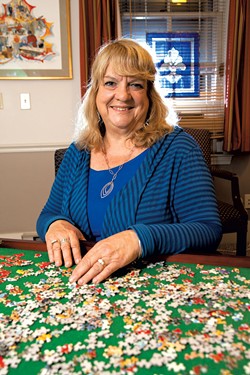
- Matthew Thorsen
Name: Maureen Finnerty Turner
Town: Burlington
Job: Hypnotherapist
Maureen Finnerty Turner is not a hypnotist. Like others in her profession of hypnotherapy, she's had to reassure clients that she would not make them quack like a duck when they are hypnotized. Such questions are less common than they used to be; these days, Turner says, clients have new concerns — for example, that a hypnotherapy session will create a "black spot" in their memories.
The popular image of hypnosis involves a swinging pocket watch and the phrase "You are getting sleeeepy." As Turner, 68, practices it at Motivation Hypnosis, hypnotherapy is a tool for helping clients cope with a wide array of issues, including insomnia, phobias and attention deficit disordern (ADD). This last is a specialty of hers: In 1995, the year Turner began studying hypnotherapy, she was diagnosed with the condition.
Turner is also the cofounder of the Northeastern Mountain Society of Clinical Hypnosis and of Hypnovations, a hypnotherapy training and education company. With one office in her hometown, Isle La Motte, and another in Burlington, Turner estimates that she sees about 30 clients each week. She spoke with Seven Days about age-regression therapy, neuropeptides and her mischievous great uncle.
SEVEN DAYS: How does one become a hypnotherapist?
MAUREEN FINNERTY TURNER: A 20-hour course called Fundamentals of Clinical Hypnosis will give you the opportunity to take advanced courses anywhere in the United States. If you want to be certified, then you need 60 credit hours from ASCH [American Society of Clinical Hypnosis]. I've taken thousands of hours of coursework over the last 20 years, and that's not hyperbole.
SD: What got you interested in hypnotherapy?
MFT: I have a fascination with the mind, and with belief change in particular. I'm a psychiatric nurse as well as a licensed, certified mental health counselor. I also had a great uncle who practiced hypnosis. He wasn't on the stage, but he was like a stage hypnotist. He would hypnotize his six brothers and two sisters at the dinner table. He was a prankster.
SD: How exactly does hypnotherapy work?
MFT: Let me explain the map first. With each level, you become more and more dissociated. At level one, you're feeling calm. It's like when you've missed your exit but you can still drive. Level two: You're feeling carefree — a "good vacation" kind of feeling. At level three, your muscles are relaxed, so you feel like a rag doll. Many of us have seen [stage hypnotists]. I know how they do what they do. I would lose my license if I did it. I don't use clinical hypnosis for entertainment; I use it for healing.
At level four, you feel light and floaty, as if you're flying. Level five is my favorite. It's not an out-of-body experience, but you're just focusing on your mind. You're feeling at one with the universe, at one with your mind. It's very, very peaceful. That's where I like to do the age-regression [therapy]. Level six — I know how to do it, but I don't do it. I'm a therapist, not an anesthesiologist. You can bring a person to a coma state.
The conscious mind, which protects the unconscious, is analytical, strategic, protective. Of our minds' activity, only 10 percent is conscious. The other 90 percent is unconscious. The unconscious resonates to imagery and metaphor.
SD: So it's pretty much mind over matter?
MFT: Anxiety is fear, every time; it's the flight response in flight or fight. At some point, usually early in somebody's life, something scary happened. If a black-and-white dog bit you when you were 2, then black-and-white dogs are going to be seen as scary. You might have forgotten [the attack] long ago, but if you saw a black-and-white dog, you still might get some increase in your heart rate. That's your unconscious saying, "Run, this is scary."
What we know from brain imagery is that, when you have a trauma, neuropeptides come and surround that event in the prefrontal lobe. It grabs anything that was going on for the 15 minutes beforehand and up to 15 minutes after, and they become triggers. Anything that you were looking at, smelling, tasting. These are then summarily put in the lateral nucleus of the amygdala. The younger [the person at the time of the trauma] and the more severe [the trauma], the more repressed the memory.
SD: What are the benefits of hypnotherapy?
MFT: For helping people do what they want to do but have problems manifesting, hypnotherapy is a wonderful way to help you get out of your own way. People come to me about their anxiety — that's the most common reason. I will teach them self-hypnosis and they will leave feeling, typically, less anxious, and able to go to sleep. I also see at least one person a month for smoking [cessation].
SD: Tell me how you treat ADD.
MFT: In my experience with people with ADD, most of the time they don't know they've got it. Hypnotherapy helps you focus. If you have ADD, one of your challenges is to be able to focus. I've developed a number of techniques [that] help people focus and manage themselves better. The biggest gift is to give them a diagnosis. The most common response is, "You mean it's not my fault?" m









Comments
Comments are closed.
From 2014-2020, Seven Days allowed readers to comment on all stories posted on our website. While we've appreciated the suggestions and insights, right now Seven Days is prioritizing our core mission — producing high-quality, responsible local journalism — over moderating online debates between readers.
To criticize, correct or praise our reporting, please send us a letter to the editor or send us a tip. We’ll check it out and report the results.
Online comments may return when we have better tech tools for managing them. Thanks for reading.